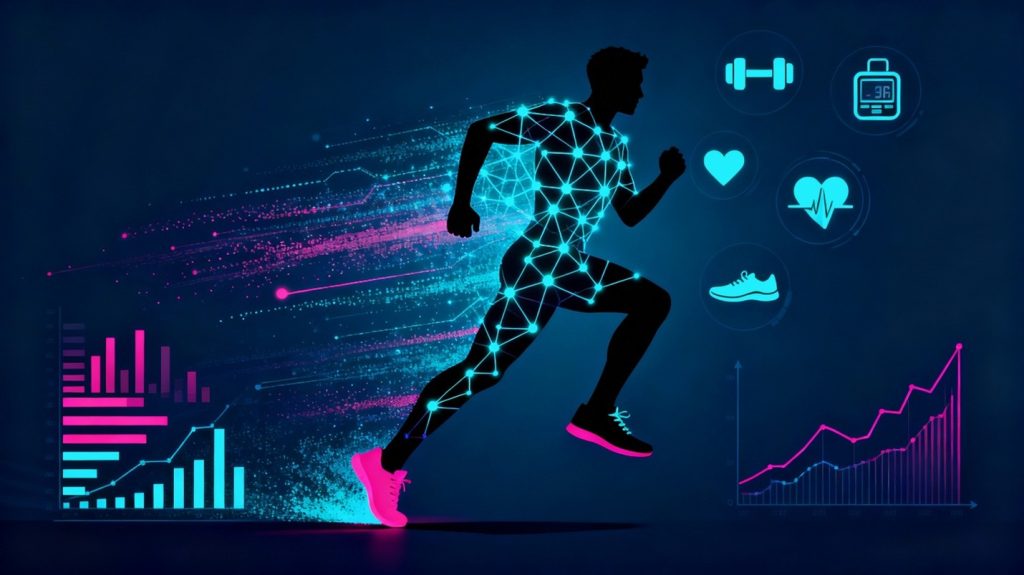PART III: Generative AI in Exercise Sciences – From Personalized Fitness to High-Performance Research

Artificial intelligence is rapidly moving from research labs into our gyms, training facilities, and personal fitness apps. It is fundamentally changing how we understand human movement, optimize performance, and prevent injury. This article explores how AI is creating customized fitness plans, analyzing biomechanics, and advancing sports performance research.
Key Point: AI is acting as a personal coach, biomechanist, and data scientist, making physical performance-level insights accessible to everyone.
| Key Questions |
| How is AI creating customized fitness and nutrition plans? |
| What role does AI play in analyzing biomechanics for performance/injury prevention? |
| How are professional sports teams using AI to advance performance? |
| What are the next frontiers for AI in personal health and fitness? |
Personalized Performance: AI’s Role in Customized Fitness Plans
The days of generic, one-size-fits-all workout plans are numbered. AI-powered applications now analyze your personal data, from wearable sensors, workout logs, and even genetic profiles to create dynamic, evolving fitness and nutrition strategies.
These tools can adjust your daily workout intensity based on your sleep quality, modify your nutrition based on your metabolic response, and provide real-time feedback to ensure your technical form is correct. This creates a hyper-personalized experience that optimizes your specific goals, whether you are a professional athlete or just starting your fitness journey.
Key Point: AI personalizes fitness by analyzing your unique data to create dynamic plans that adapt in real time.

Decoding Movement: AI for Biomechanical Analysis
Understanding how you move is critical for improving performance and preventing injury. AI-driven biomechanics platforms use simple smartphone cameras or wearable sensors to capture and analyze complex human movements. This technology, once reserved for elite sports labs, is now widely accessible even to the general population.
By processing thousands of data points, AI can identify subtle movement inefficiencies, muscular imbalances, or form errors that are less evident even to a trained human eye. This allows physical therapists, coaches, and individuals to receive immediate, actionable feedback, leading to safer and more effective training.
Key Point: AI makes professional-grade movement analysis accessible, using video to identify injury risks and optimize technique.
| AI Tool Type | Application in Biomechanics | Potential Outcome |
| Computer Vision | Analyzes video from a camera to track joint angles and body position. | Real-time form correction during a functional movement. |
| Wearable Sensors | Sensors that measure force, acceleration, and orientation. | Identifies risky landing patterns in athletes to prevent ACL injuries. |
| Machine Learning | Models predict movement patterns or classify injury risk. | Assess runner’s gait to recommend corrective exercises. |
The Data-Driven Athlete: Advancing Sports Performance
Professional sports organizations are leveraging AI to gain a more competitive edge. By analyzing massive datasets from training, competition, and wearables, AI models can identify patterns that facilitate team strategy, manage fatigue, and predict performance.
This data-driven approach allows coaches to move beyond intuition and make data-informed decisions. AI can help determine the optimal training load for an athlete to “peak” at the right time, identify tactical formations most likely to succeed against a specific opponent, and even scout new talent by analyzing performance metrics.
Key Point: AI sifts through massive datasets to find performance-boosting insights that are beyond typical human analytic capabilities.
Takeaway
From customized workouts on your phone to strategic decisions of professional teams, AI is the new secret ingredient in exercise science. It is personalizing fitness, deepening our understanding of human movement, and unlocking new levels of performance. The challenge now is to ensure these powerful tools are used ethically and effectively to help everyone move safer and perform better.
AI makes complex sports data more useful, helping coaches and scientists turn information into better performance decisions.
— Craig Pickering, sports scientist and Olympian, writing on AI’s transformative impact in exercise science.
References
- Dergaa, Ismail et al. Using artificial intelligence for exercise prescription in personalised health promotion: A critical evaluation of OpenAI’s GPT-4 model. Biology of Sport. 2024. doi:10.5114/biolsport.2024.133661.
- Souaifi, Marouen et al. Artificial Intelligence in Sports Biomechanics: A Scoping Review on Wearable Technology, Motion Analysis, and Injury Prevention. Bioengineering. 2025. doi:10.3390/bioengineering12080887.
- Khan I, Murad S, Khalid M, Ramzan H, Khan HH. Wearables, Smart Textiles & AI Biomechanics in Sports: A Narrative Review. Premier Journal of Science. 2025. https://doi.org/10.70389/PJS.100112
Useful Resources
- Discover the Division of Food, Nutrition, and Exercise Sciences at Mizzou: Food, Nutrition and Exercise Sciences
- Explore Sports Tech Trends: Discover how the American College of Sports Medicine (ACSM) covers AI and wearable tech as a top trend in fitness: ACSM
- Stay Ahead in Sports Science: Explore in-depth insights on biomechanics, artificial intelligence, and the latest trends driving sports technology: Scienceye Blog.
- See AI in Pro Sports: Dive into how professional leagues are using data analytics to drive performance and fan engagement: NBA’s Official Stats Page on NBA.com
FAQs
- Is AI-driven fitness advice safe? AI provides powerful suggestions based on data, but it’s not a replacement for a qualified professional. Always consult a doctor or certified trainer, especially if you have pre-existing health conditions.
- Do I need expensive equipment to use AI for fitness? No. Many of the most powerful AI biomechanics tools are now software-based and can use the camera already on your smartphone.
- How do professional sports teams use AI? Teams use AI for everything from player load management (preventing overtraining) and tactical analysis (predicting opponent plays) to scouting new talent based on performance data.
Produced by:
Daniel Credeur, PhD
Associate Teaching Professor in Food, Nutrition, and Exercise Sciences
Provost’s AI Fellow for CAFNR